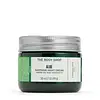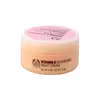What's inside
What's inside
 Key Ingredients
Key Ingredients

No key ingredients
 Benefits
Benefits

 Concerns
Concerns

 Ingredients Side-by-side
Ingredients Side-by-side

Water
Skin ConditioningPropanediol
SolventGlycerin
HumectantCaprylic/Capric Triglyceride
MaskingButylene Glycol
HumectantCoco-Caprylate/Caprate
EmollientGlyceryl Stearate Citrate
EmollientMyristyl Myristate
EmollientElaeis Guineensis Oil
EmollientOctyldodecanol
EmollientSesamum Indicum Seed Oil
EmollientSqualane
EmollientButyrospermum Parkii Butter
Skin ConditioningCetearyl Alcohol
EmollientCetyl Alcohol
EmollientPhenoxyethanol
PreservativeCaprylyl Glycol
EmollientAloe Barbadensis Leaf Juice Powder
Skin ConditioningAcrylates/C10-30 Alkyl Acrylate Crosspolymer
Emulsion StabilisingSodium Gluconate
Skin ConditioningCentella Asiatica Leaf Extract
Skin ConditioningXanthan Gum
EmulsifyingSodium Hydroxide
BufferingCitric Acid
BufferingWater, Propanediol, Glycerin, Caprylic/Capric Triglyceride, Butylene Glycol, Coco-Caprylate/Caprate, Glyceryl Stearate Citrate, Myristyl Myristate, Elaeis Guineensis Oil, Octyldodecanol, Sesamum Indicum Seed Oil, Squalane, Butyrospermum Parkii Butter, Cetearyl Alcohol, Cetyl Alcohol, Phenoxyethanol, Caprylyl Glycol, Aloe Barbadensis Leaf Juice Powder, Acrylates/C10-30 Alkyl Acrylate Crosspolymer, Sodium Gluconate, Centella Asiatica Leaf Extract, Xanthan Gum, Sodium Hydroxide, Citric Acid
Water
Skin ConditioningGlycerin
HumectantTriticum Vulgare Germ Oil
EmollientDimethicone
EmollientPPG-2 Myristyl Ether Propionate
EmollientStearyl Alcohol
EmollientIsododecane
EmollientCetearyl Alcohol
EmollientTheobroma Cacao Seed Butter
EmollientMyristyl Myristate
EmollientGlyceryl Stearate
EmollientPEG-100 Stearate
Cetearyl Ethylhexanoate
EmollientPanthenol
Skin ConditioningHydrogenated Tetradecenyl/Methylpentadecene
SolventPhenoxyethanol
PreservativeCaprylyl Glycol
EmollientTocopheryl Acetate
AntioxidantCarbomer
Emulsion StabilisingParfum
MaskingBenzyl Benzoate
AntimicrobialSodium Hydroxide
BufferingSodium Hyaluronate
HumectantDisodium EDTA
Benzyl Alcohol
PerfumingHydroxycitronellal
PerfumingGeraniol
PerfumingLinalool
PerfumingLimonene
PerfumingAlpha-Isomethyl Ionone
PerfumingCI 14700
Cosmetic ColorantCI 19140
Cosmetic ColorantWater, Glycerin, Triticum Vulgare Germ Oil, Dimethicone, PPG-2 Myristyl Ether Propionate, Stearyl Alcohol, Isododecane, Cetearyl Alcohol, Theobroma Cacao Seed Butter, Myristyl Myristate, Glyceryl Stearate, PEG-100 Stearate, Cetearyl Ethylhexanoate, Panthenol, Hydrogenated Tetradecenyl/Methylpentadecene, Phenoxyethanol, Caprylyl Glycol, Tocopheryl Acetate, Carbomer, Parfum, Benzyl Benzoate, Sodium Hydroxide, Sodium Hyaluronate, Disodium EDTA, Benzyl Alcohol, Hydroxycitronellal, Geraniol, Linalool, Limonene, Alpha-Isomethyl Ionone, CI 14700, CI 19140
 Reviews
Reviews

Ingredients Explained
These ingredients are found in both products.
Ingredients higher up in an ingredient list are typically present in a larger amount.
Caprylyl Glycol is a humectant and emollient, meaning it attracts and preserves moisture.
It is a common ingredient in many products, especially those designed to hydrate skin. The primary benefits are retaining moisture, skin softening, and promoting a healthy skin barrier.
Though Caprylyl Glycol is an alcohol derived from fatty acids, it is not the kind that can dry out skin.
This ingredient is also used as a preservative to extend the life of products. It has slight antimicrobial properties.
Learn more about Caprylyl GlycolCetearyl alcohol is a mixture of two fatty alcohols: cetyl alcohol and stearyl alcohol. It is mainly used as an emulsifier. Emulsifiers help prevent the separation of oils and products. Due to its composition, it can also be used to thicken a product or help create foam.
Cetearyl alcohol is an emollient. Emollients help soothe and hydrate the skin by trapping moisture.
Studies show Cetearyl alcohol is non-toxic and non-irritating. The FDA allows products labeled "alcohol-free" to have fatty alcohols.
This ingredient is usually derived from plant oils such as palm, vegetable, or coconut oils. There is debate on whether this ingredient will cause acne.
Due to the fatty acid base, this ingredient may not be Malassezia folliculitis safe.
Learn more about Cetearyl AlcoholGlycerin is already naturally found in your skin. It helps moisturize and protect your skin.
A study from 2016 found glycerin to be more effective as a humectant than AHAs and hyaluronic acid.
As a humectant, it helps the skin stay hydrated by pulling moisture to your skin. The low molecular weight of glycerin allows it to pull moisture into the deeper layers of your skin.
Hydrated skin improves your skin barrier; Your skin barrier helps protect against irritants and bacteria.
Glycerin has also been found to have antimicrobial and antiviral properties. Due to these properties, glycerin is often used in wound and burn treatments.
In cosmetics, glycerin is usually derived from plants such as soybean or palm. However, it can also be sourced from animals, such as tallow or animal fat.
This ingredient is organic, colorless, odorless, and non-toxic.
Glycerin is the name for this ingredient in American English. British English uses Glycerol/Glycerine.
Learn more about GlycerinMyristyl Myristate is created from the fatty acids of myristyl alcohol and myristic acid. In skincare, it is an emollient and texture enhancer.
On its own, this ingredient has a comedogenicity index of 5/5. This means it has the potential to clog pores. When diluted with cetyl alcohol or propylene glycol, the comedogenicity will decrease.
This ingredient may not be Malassezia folliculitis, or fungal-acne safe.
Nutmeg, palm kernel oil, and coconut oil all contain this ingredient naturally.
Learn more about Myristyl MyristatePhenoxyethanol is a preservative that has germicide, antimicrobial, and aromatic properties. Studies show that phenoxyethanol can prevent microbial growth. By itself, it has a scent that is similar to that of a rose.
It's often used in formulations along with Caprylyl Glycol to preserve the shelf life of products.
Sodium Hydroxide is also known as lye or caustic soda. It is used to adjust the pH of products; many ingredients require a specific pH to be effective.
In small amounts, sodium hydroxide is considered safe to use. However, large amounts may cause chemical burns due to its high alkaline.
Your skin has a natural pH and acid mantle. This acid mantle helps prevent harmful bacteria from breaking through. The acid mantle also helps keep your skin hydrated.
"Alkaline" refers to a high pH level. A low pH level would be considered acidic.
Learn more about Sodium HydroxideWater. It's the most common cosmetic ingredient of all. You'll usually see it at the top of ingredient lists, meaning that it makes up the largest part of the product.
So why is it so popular? Water most often acts as a solvent - this means that it helps dissolve other ingredients into the formulation.
You'll also recognize water as that liquid we all need to stay alive. If you see this, drink a glass of water. Stay hydrated!
Learn more about Water